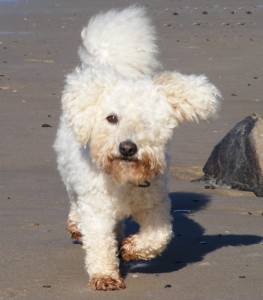Since the beginning of the year but particularly in the past month much of our time and energy has been devoted to the vexing question as to what to do with our animals as we prepare for a lengthy sojourn in Europe. We had already decided to have our mare join Vicki for the year-long course with Klaus. So what would we do with our little, old dog and our two elderly thoroughbred geldings? While exploring the various options for travel and staying put, the responses we received from the organisations and people we have spoken to have led me to ponder the question of just how much dog is in a horse?
The dog is a 16-year old Bichon Frise who is doing remarkably well for his age thanks to a diet of raw meat, vegetables and fruit, a rural lifestyle and large doses of love and affection. And yes, he only has one eye, the other lost to a stick at play while a puppy. Initially, we were thankful that Klaus had postponed the course for three months, so giving us more time with Dubu. Now we realise that Dubu is unlikely to leave this earth after this ‘reprieve’ and that, if he is to travel, it will be easier for him to do so when he is younger. Three months can matter greatly at this age.
Accordingly, we have decided to leave for Europe at the beginning of May as originally planned. Our plan is to take Dubu as excess baggage and to have a one or two-day break in a pet-friendly hotel en route. The only vaccinations we are prepared to accept are what is absolutely necessary to get him into the EU. We explored the usual Asian routes used by the pet carriers but found no satisfactory solution. Japan seemed the best option despite the bureaucratic entry and exit requirements but finding a pet-friendly hotel which did not insist on the entire gammut of vaccinations has proved to be impossible. Thankfully, a solution was forthcoming when we shifted our focus to a route via the USA.
Almost everyone we spoke to felt that our concerns were quite normal, if perhaps tending towards the excessive. You could almost sense the resignation: this is what we Westerners do with dogs.
You can see it too in the way many little puppies (almost all stereotypically white) are pampered and spoilt by their concerned and frequently wealthy owners. Put a horse in the hands of the same person however, and suddenly you are faced with a different breed of human, who will think nothing of treating it as little more than a beast of burden to be trotted and cantered for an hour without any meaningful breaks, to be pushed and pulled from one social equestrian event to another, and to be sculpted into the ideal shape with the aid of bit, double-bridle, whip and spurs. The horse is made to serve as an accessory to its owner’s ego using any means at the latter’s disposal, something which that person would probably consider to be too ghastly to contemplate in the case of a dog.
While this is obviously an extreme example (albeit all too common), our concerns about our horses have also been greeted with a resonating sense of disbelief and laboured tolerance. Your mare is about to be separated from her little herd and torn from her closest friend, and you would like to be there for her while she is quarantine, would you? Cringe, how dare we accord our horse the same level of concern as our dog.
So how much dog is in a horse? Put another way, should humans not be as caring about horses as they are about dogs? Put in yet another way, can humans expect to dance with horses without being as caring? What is required of us humans to learn to dance with horses? And finally, if we learn to dance with horses, how will we be changed by the time we come to do so? These are questions we hope to find answers to during our year on the island of Lyö.



